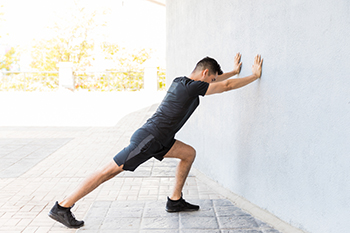
The Achilles tendon connects the calf muscles to the heel and is essential for walking, running, and jumping. When this tendon becomes overused or strained, it can lead to Achilles tendinitis, which causes swelling and pain at the back of the ankle. A podiatrist may recommend rehabilitation exercises to promote healing and restore strength. One key movement is the eccentric heel drop, which involves rising up on both feet and then slowly lowering the body down using only the injured leg. This helps lengthen and strengthen the tendon under controlled tension, improving resilience without excessive strain. Other useful exercises include towel stretches to loosen the calf and plantar fascia, step-ups to rebuild balance, and toe raises to improve foot control. These exercises should be performed gradually and with care to avoid further Achilles tendon damage. A podiatrist can track your recovery, recommend modifications, and determine if further treatment is needed. If you have sustained an Achilles tendon injury, it is suggested that you schedule an appointment with a podiatrist for an exam and appropriate treatment options.
Achilles tendon injuries need immediate attention to avoid future complications. If you have any concerns, contact Vrunda Dalal, DPM of Sole Focus Foot and Ankle. our doctor can provide the care you need to keep you pain-free and on your feet.
What Is the Achilles Tendon?
The Achilles tendon is a tendon that connects the lower leg muscles and calf to the heel of the foot. It is the strongest tendon in the human body and is essential for making movement possible. Because this tendon is such an integral part of the body, any injuries to it can create immense difficulties and should immediately be presented to a doctor.
What Are the Symptoms of an Achilles Tendon Injury?
There are various types of injuries that can affect the Achilles tendon. The two most common injuries are Achilles tendinitis and ruptures of the tendon.
Achilles Tendinitis Symptoms
- Inflammation
- Dull to severe pain
- Increased blood flow to the tendon
- Thickening of the tendon
Rupture Symptoms
- Extreme pain and swelling in the foot
- Total immobility
Treatment and Prevention
Achilles tendon injuries are diagnosed by a thorough physical evaluation, which can include an MRI. Treatment involves rest, physical therapy, and in some cases, surgery. However, various preventative measures can be taken to avoid these injuries, such as:
- Thorough stretching of the tendon before and after exercise
- Strengthening exercises like calf raises, squats, leg curls, leg extensions, leg raises, lunges, and leg presses
If you have any questions please feel free to contact our office located in Marlton, NJ . We offer the newest diagnostic tools and technology to treat your foot and ankle needs.

